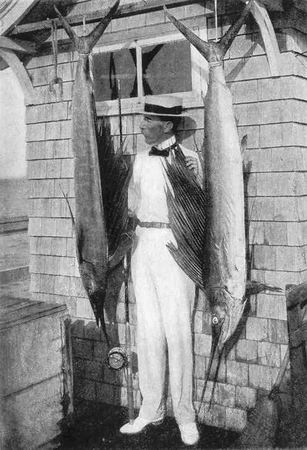|
1999-2003 (Return to Web Text-ures) |
Click Here to return to |
|
1999-2003 (Return to Web Text-ures) |
Click Here to return to |
XII
THE SAILFISH
(Istiophorus nigricans)
THE sailfish belongs to the same family as the spearfish and is to be found in the warm waters of the West Indies and in the Gulf stream along the coast of southern Florida.
The sailfish are long and slim of body and not of great weight. A fish that is seven feet long will as a rule weigh under fifty pounds.
Their peculiarity is their large indigo blue dorsal fin and it is difficult to fathom the purpose for which this fin is intended. The theory that these fish lie on the surface and work to windward with their sail-like fin is a romance, nor do they seem to use it when swimming beneath the surface. The fin houses in a slot and I have never seen it in use except when this active fish is jumping about on the surface of the ocean, feeding, or rapidly travelling seaward; then it seems to be used as a rudder or guide, for the fish open and close it as they drive and jump along from wave to wave.
“The chief motive and jumping power of a fish is in its tail which as it hits the water straightens out the curving body and shoots it forward, allowing the pectoral and ventral fins to strike flat with their full power. The caudal, dorsal, and anal or vertical fins have steering functions to perform, while the pectoral and ventral pairs of fins are chiefly intended for balancing purposes.
Fish would be unable to navigate on an even keel without these horizontal fins, for the centre of gravity of most fish is toward the head or dorsal side.
To help matters a fish is supplied with an air-sack which renders it bulk for bulk about the same weight as the water it displaces.”

SAILFISH
The sailfish are most interesting fish to hunt after, for they are usually found in schools and can often be seen jumping above the surface of the sea.
They are not an easy fish to follow, for they are here, there, and everywhere for a few moments and then suddenly disappear.
Although they are a quick moving, agile fish, they are delicate biters and it requires patience and skill to hook them. At first it was supposed to be necessary to bait with a silver mullet in order to entice a sailfish to take, and they were difficult to hook, for it was found that they would mouth this large bait for some time before swallowing it. It is now the custom to fish for them with a long strip of cut-bait, preferably mullet, but any cut-bait seems to serve when they are taking well.
It is often possible to see the fish approaching, in which case it is wise to allow the bait to remain stationary by slowly circling with the boat and giving line before striking, for the fish needs time in which to decide whether the morsel presented is really to its taste and, if so, may hold it in its beak for a time before the hook is in a position where it will hold when driven home.
Considering their weight the hooked sailfish fight hard. They jump many times, stand on their tails and perform other unexpected gymnastic feats, but as they tire, their sail-like dorsal fin seems to hamper their action.
As a game fish it has not long been known. The first was taken on a rod about twelve years ago. Twenty-five sailfish in a day is the record at Palm Beach for an exceptional day’s sport enjoyed by the members of the Sailfish Club, and the record fish measured a trifle over eight feet in length.
The following fish story is from the Paris Figaro:
MARINE MONSTER CAPTURED
A huge sailfish, a
fish rarely met with in the Atlantic, has been captured by fishermen off
Concarneau and towed to that port. The fish measures eight metres long and four
metres in circumference and weighs tour tons. The fishermen are greatly
disturbed over the presence in the vicinity of the fish’s female companion, who
followed her captured lord throughout the whole of the night he was being towed
to port.
—Figaro, 1914.
The fish mentioned must have been a Tetrapturus amplus, the third and only other member of the istiophoridae. It is a rare fish and is said to grow to a great size. This fish is known in Cuba as the aguja casta.
Click
here to continue to the next chapter of
Some Fish and Some Fishing